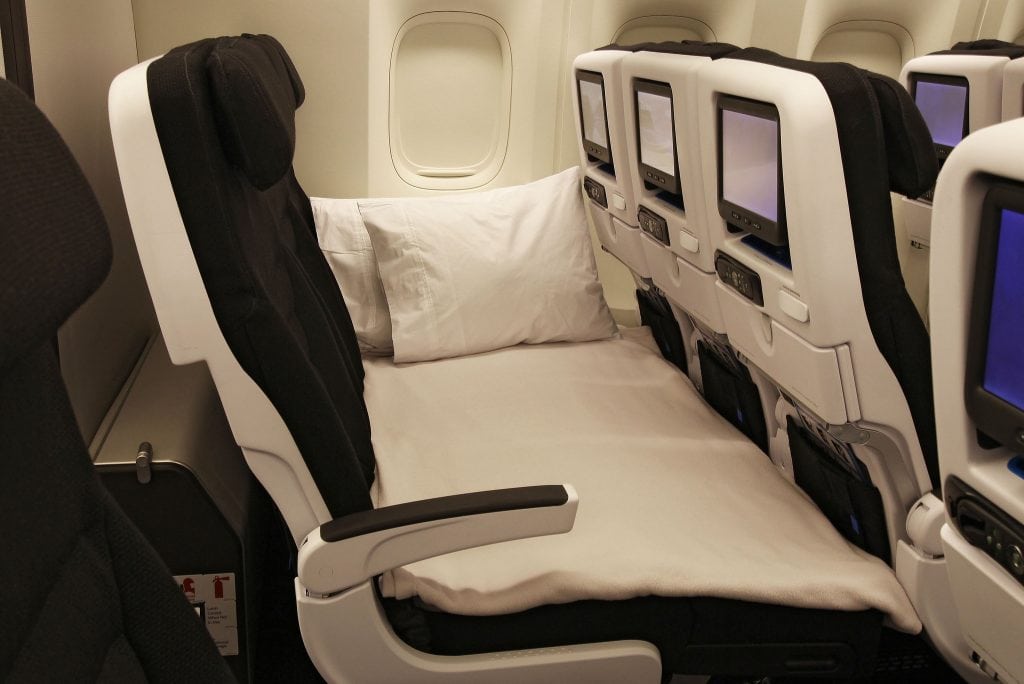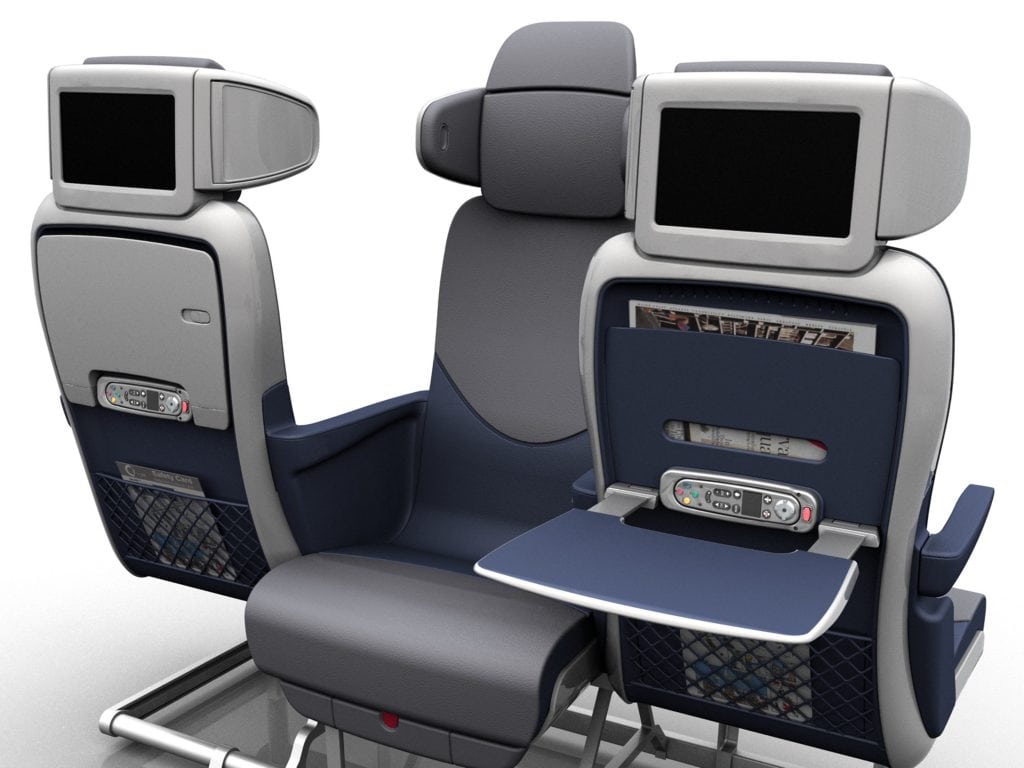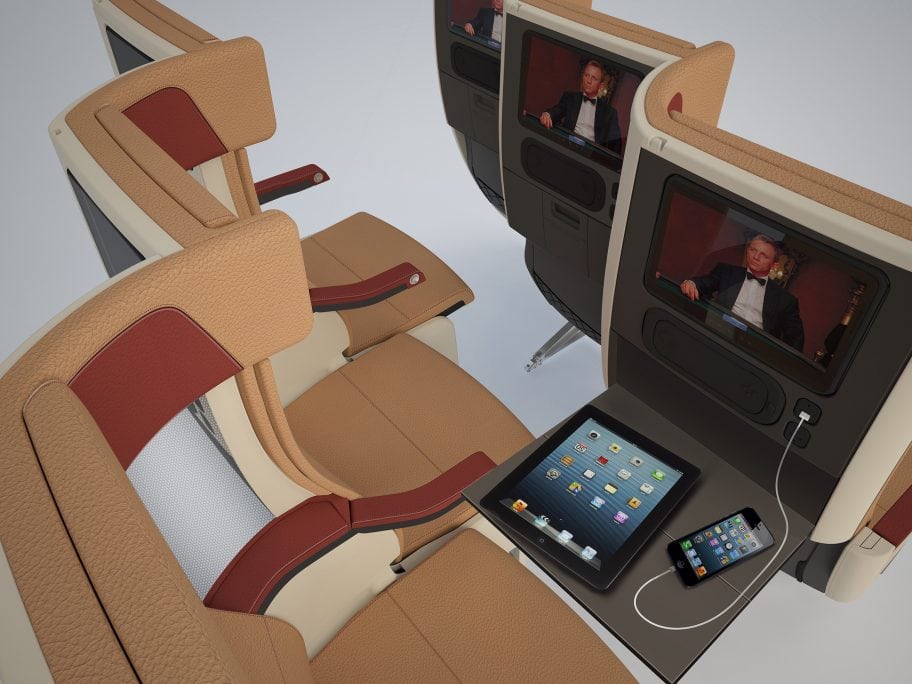Skift Take
Feel free to read as many articles as you want about new coach concept seats. But let's be honest: The coach configuration on most planes hasn't changed in decades, and it's probably not going to change any time soon.
Across London, workers at at least three design studios — the same people creating opulent premium class suites for wealthy travelers — spend a surprising amount of time thinking and doodling about how to make long-haul coach class more comfortable.
And yet, for the past five decades, almost nothing has changed. Long-haul economy class remains roughly as it was in the late 1960s, when Boeing introduced the 747, the world’s first widebody aircraft. Today, as then, on planes that cross oceans you’ll typically find two or three seats near the windows on each side, and three to four in a center section. About the only major difference is that the seats are a bit narrower, as airlines realized they could add more seats by shrinking each chair slightly.
“Where is the revolution?” asked Anthony Harcup, a designer at Acumen, the London firm that helped United Airlines create its new Polaris business class cabin. “The front end of the aircraft is unrecognizable from where we were 20 years ago, so it really does press the question, why does economy still look like it did?”
Yes, airlines have embraced advances that make eight to 15-hour journeys better. Travelers can usually watch television programs and movies on a screen mounted in front of them. Many airlines also now offer in-flight WiFi for a fee, allowing passengers, especially business travelers, more chances to be productive. More carriers are installing extra-wide premium economy seats, some with leg-rests, although premium economy is not really coach class despite its name.
Changes to regular coach seats, however, have been minor. The designers say the headrests are more comfortable than they were, while seats are a little thinner than in the past. They also note that one of the greatest breakthroughs happened recently when airlines discovered they could give passengers more knee room by moving the magazine rack from the bottom of the seat-back to the top. Of course, many carriers used this advance as an excuse to shrink space between seats.
Why is coach so stagnant?
It’s not that no one has tried to improve economy class or even because airlines don’t want to make coach more comfortable. Changing an aircraft’s interior is not an inexpensive or easy task, and so far no airline has been interested in disrupting what works. That’s in part because an airline would need help from seat-makers, who are so busy churning out traditional coach seats that they have little impetus to change. Today’s seats are safe, reliable, and relatively lightweight. They’re also an efficient use of space.
“It’s not because of a lack of interest from airlines,” said Adam White, a director at factorydesign, the London firm that designed the new Delta Air Lines business class suite, complete with a sliding door for privacy. “Airlines we talk to are desperate to engage in creating a better product in economy, but for seat makers, it’s the most difficult product to change because it’s a volume product.”
Concept Seats: Fun but Rarely Viable
Almost every year, at a trade show in Hamburg, Germany, seat designers share new ideas — and many are delightfully innovative.
They might turn some coach seats backwards, a tweak that could give each passenger more knee and shoulder room, while not decreasing the overall seat count. Or they might stagger seats, so passengers in the same row are actually a few inches from each other. They might even copy movie theater seats, so the seat cushion folds up when no one is seated. That would make it easier for a window passenger to reach the aisle.
News websites often cover the concept seats, promoting them with clickbait headlines, and suggesting airlines may finally be ready to try something new. But in reality, airlines probably are far from altering the status quo.
“There is no real commericial incentive right enough for an airline to invest in what is obviously the risk of a new seat platform development,” Acumen’s Harcup said. “Something needs to change in the commercial framework of the industry if we are going to see any real change happen.”
As much as designers dream of remaking coach class, some admit they’re content with smaller victories. London-based PriestmanGoode, which has handled cabin redesign projects for many carriers, including United, Lufthansa and Swiss, is working on a new coach seat that it claims should be slightly more comfortable than today’s typical model.
Because the design space is so competitive — all the companies are competing for the same airline business —PriestmanGoode director Nigel Goode is coy about exactly what his firm is planning, but it appears to be just an incremental advance.
“Manufacturers spent a lot of time working on the mechanism of the seat so it gives you a little bit more recline,” Goode said, describing PriestmanGoode’s innovation. “It’s just small differences. [But] the response from it has been incredibly good.”
At factorydesign, White’s team is also exploring top-secret projects that might improve economy class. But he, too, is realistic about what his firm can accomplish. Coach class designers are working under intense space constraints, he said, so there’s only so many options.
“I love to believe there will be a revolution in economy, and it may be that it will come,” he said. “I enjoy the sort of concepts we see every year at Hamburg for kneeling or half-standing or whatever it is, but in a way they’re illustrating my point. There is only so much space allocated to economy class.”
Seat Makers Slow Innovation
While airlines ultimately will decide whether to rethink economy class, designers tend to reserve their criticism for the handful of seat manufacturers that produce most airline seats.
The companies tend to have one priority — finding a seat that can be certified by safety regulators and can be mass produced with limited difficulty.
“They are engineering companies when they need to be furniture manufacturers,” Goode said.
Seat manufacturers such as Recaro, Zodiac, and B/E Aerospace need to make tens of thousands of coach seats. Sometimes, manufacturers produce concept seats — Zodiac has developed seats that fold-up, movie-theater style, while another firm called Thomson Aeroseating worked with Acumen to develop new, staggered coach seating — but these ideas tend to fizzle. And that’s likely fine with the manufacturers, as it is easier for the them to produce seats already certified by safety regulators.
The manufacturers are more willing to work with airlines on bespoke premium seats for a couple of reasons, the designers say. Those seats cost a lot more — often $100,000 or more — per unit. Airlines also need fewer of them.
For airlines, it makes sense to invest in premium classes, as revenues from those seats are higher than coach, even accounting for the fact that they take up more room. Still, even in first and business class, it can be tough to persuade seating companies to try something new, which is why many airlines use the same seats, and then dress them with small touches to match their branding. (For all the innovation of Delta’s new suite, the carrier is essentially using the same seat as many of its competitors.)
“The margins are so much bigger in business class and first class,” Harcup said. “Economy is a much more conservative and risk-averse sector, which is why changes come so much more incrementally. It is hard to incrementally change into a revolution. There has to be new product that sets a new benchmark.”
At one point, Harcup said, Acumen had an airline willing to try a new seating concept, though he declined to name the airline or the configuration. The problem, he said, was that the airline did not want to license the seat to competitors, so a seating manufacturer could not make a big profit selling it to other carriers. Acumen and the airline tried to find a manufacturer willing to make the the seat, but no one wanted the business.
“All the suppliers, ‘no bid it,” Harcup said. “It was really everybody. So the planets need to align for us to move forward given the current market climate.”
That’s not a surprise to factorydesign’s White, who notes that most manufacturers have enough seats on order to keep them busy for years.
“I’ve seen airlines ask seat makers to do something different and they have turned around and said, ‘No, we can’t. We don’t have the capacity,'” White said.

Skycouch by Air New Zealand is one of the only innovative coach products to reach market in the past two decades. Photo: Roderick Eime/Flickr.
An Incremental Approach
Ask the seat designers to name one truly innovative economy product from the past two decades, and they often have the same response: Skycouch, developed in 2010 by Air New Zealand.
The airline took three coach seats and turned them into a narrow bed that can be shared by two adults, or two adults and a child. It’s not exactly business class — the bed is only five-feet-one inches long — but for most travelers, it’s better than economy. It’s also a decent value, with an upgrade to Skycouch usually priced at less than the cost of three coach seats.
“I think Air New Zealand’s Skycouch was a delightful thing to see because it’s so easy to do,” factorydesign’s White said. “We must have all wondered why you couldn’t lie down in that space. But the fact that that’s been it, in 60 years of making the same seats, it’s a fairly good indication of how bloody hard it is.”
Six years later, though, only Taiwan’s China Airlines has copied Skycouch.
Given the difficulty in implementing truly new seating configurations, the designers tend to argue that coach will improve incrementally.
Designers might seek to improve seemingly minor problems with coach. Perhaps a carrier might move the headphone jack to a place where it is most convenient for passengers, or add power to a spot where it’s easy for a traveler to actually plug into it. Or, more airlines could put tablet holders in coach. Carriers might also follow a suggestion from Hong Kong-based design firm Paperclip and embed a cupholder into the seat-back.
Goode said airlines should also ensure in-seats screen are well integrated into the seat, rather than treated as an afterthought.
“If you’ve got a big clunky screen on the back of your seat, you’re just going to think it’s inferior,” Goode said. “The technology behind it might cost eight times as much as your phone, but it [might look like] a $20 screen from somewhere or other.”
Airlines might make cabins feel more welcoming, perhaps by replacing grays with colors that match a carrier’s branding. PriestmanGoode is responsible for United’s new coach interior, with blue seat coverings meant to make United stand out. “We spent a lot of time with manufacturers getting the stitching right,” Goode said.
Another option is to give passengers more room to roam and more control over their experiences, said Adrian Berry, another director of factorydesign.
“One of the key things will be about touch-points in the aircraft that passengers can go to,” he said. “Maybe it is grazing or getting water. Simple things done well that show you care about the environment. It is how you can alleviate some of the class issues.”
There are other minor approaches, too. In the United States, Frontier Airlines recently installed middle seats that are one inch wider than the windows and aisles, an approach it took to make the worst seats on the plane slightly better.
Seattle’s Teague, another design firm, wants to take that one step further. It has proposed that airlines find a sponsor for middle seats. The sponsors might give customers wedged between the window and aisle some promotional gifts, which presumably would make the center seat more bearable. An airline might even be able to clear some profit on the sponsorship deal.
Have a confidential tip for Skift? Get in touch
Tags: passenger experience
Photo credit: Several years ago London design firm Acumen developed a new forward-backward coach seating configuration that it claims will give each passenger more room. But it is unlikely this configuration will ever appear on an airline. Acumen


